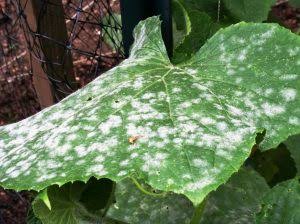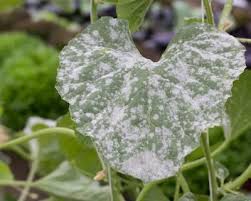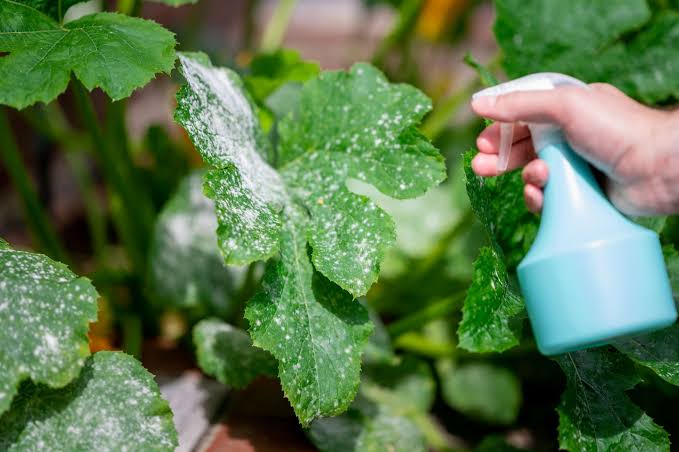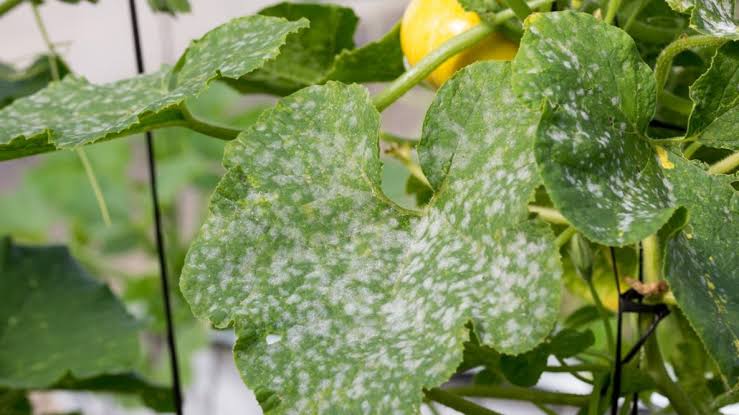Powdery mildew, scientifically known as Erysiphales, is a pesky fungal disease that affects various plants, causing distress among gardeners and farmers alike. This powdery culprit thrives in diverse climates, striking fear into the hearts of those who cultivate plants for sustenance and beauty.
Imagine a fine, white powder delicately coating the leaves, stems, and sometimes even the flowers of your favorite plants – that’s the signature of powdery mildew. It doesn’t discriminate; it can affect a wide range of plants, from roses in your garden to the vegetables in your kitchen.
The life story of powdery mildew begins with tiny spores. These microscopic invaders land on plant surfaces, seeking the ideal conditions to establish their powdery empire. Unlike many fungi, powdery mildew doesn’t need water on the plant surface to germinate. Instead, it thrives in dry conditions, making it a formidable foe even in arid climates.
Once settled, the fungus forms a delicate network of threads on the plant’s surface, drawing nutrients and sapping vitality. The affected plant then bears the brunt of this invasion, displaying telltale signs of distress. Leaves become distorted, and the characteristic powdery coating emerges, signaling the presence of this fungal antagonist.
As the battle between plant and powdery mildew ensues, it’s essential to understand that prevention is often the best defense. Adequate spacing between plants, promoting good air circulation, and maintaining proper hygiene in your garden can go a long way in thwarting the advances of this fungal adversary.
Various treatments exist for powdery mildew, ranging from homemade remedies to commercial fungicides. Some opt for a concoction of baking soda and water, while others turn to neem oil or sulfur-based solutions. However, prevention remains key, as once powdery mildew takes hold, reversing its effects can prove challenging.
Powdery mildew, or Erysiphales, stands as a formidable foe in the world of plant cultivation. Its subtle invasion, marked by a powdery residue, poses a threat to the aesthetic and nutritional aspects of our gardens. Armed with knowledge and preventative measures, gardeners can cultivate a defense against this fungal intruder, ensuring the well-being of their beloved plants.
Read Also: 18 Medicinal Health Benefits Of Linum usitatissimum (Flax)
Plants Affected by Powdery Mildew (Erysiphales)

Powdery mildew doesn’t discriminate when it comes to its choice of victims. It can affect a wide variety of plants, ranging from ornamental flowers to essential crops. Some common plants that frequently fall prey to powdery mildew include roses, zinnias, cucumbers, pumpkins, squash, and various fruit trees like apples and peaches.
This fungal menace isn’t selective in its targets, making it a concern for gardeners and farmers alike. Whether you’re tending to your flower beds or cultivating essential crops, vigilance against powdery mildew is crucial to maintaining the health and vitality of your plants.
The insidious nature of powdery mildew means that it doesn’t only affect the external appearance of plants but can also compromise their overall health. As this fungal invader takes hold, leaves often become distorted and discolored, affecting the plant’s ability to photosynthesize effectively.
Roses, with their delicate and often prized blooms, are particularly susceptible to powdery mildew. The once-vibrant and colorful petals can be marred by the powdery residue, diminishing the visual appeal of these beloved flowers.
Vegetable gardens also face constant threats, with cucumbers, pumpkins, and squash falling victim to powdery mildew. This not only jeopardizes the yield of these crops but can also impact the quality and taste of the produce.
Fruit trees, essential for providing us with a variety of delicious fruits, are not spared from the reach of powdery mildew. Apples and peaches, in particular, may find themselves under attack. The powdery coating can compromise the quality of the fruit and potentially reduce harvests, affecting both home gardeners and commercial orchards.
It’s worth noting that while these are common examples, powdery mildew can afflict many other plant species. Its adaptability and widespread occurrence make it a challenge for anyone engaged in plant cultivation, emphasizing the importance of proactive measures to prevent and manage its impact across a broad spectrum of flora.
Damages Caused by Powdery Mildew

Powdery mildew wreaks havoc on plants, causing a range of damages that extend beyond mere cosmetic issues. As this fungal intruder establishes its presence, it inflicts several detrimental effects on the affected plants.
1. Reduced Photosynthesis: Powdery mildew forms a powdery layer on the plant’s leaves, hindering their ability to capture sunlight effectively. This interference with photosynthesis, the process by which plants convert light into energy, can lead to reduced growth and overall diminished plant vigor.
2. Distorted Growth: The fungus doesn’t just settle for disrupting photosynthesis; it also interferes with the normal growth of plant tissues. Leaves may become distorted, affecting the plant’s natural form and potentially compromising its structural integrity.
3. Decreased Yield and Quality: In crops, such as cucumbers, pumpkins, and fruit trees like apples and peaches, powdery mildew can result in reduced yields and lower-quality produce. This has implications for both home gardeners and commercial agricultural practices, impacting the availability and quality of essential food resources.
4. Predisposition to Other Issues: Plants weakened by powdery mildew become more susceptible to other pests and diseases. The compromised state of the plant provides an entry point for further infections, creating a domino effect of health issues.
5. Aesthetic Decline: Beyond the functional impacts, there’s a noticeable aesthetic decline when powdery mildew takes hold. Ornamental plants like roses and zinnias lose their visual appeal as the characteristic powdery coating mars their once-beautiful appearance.
6. Economic Consequences: For commercial growers, the damages caused by powdery mildew can translate into significant economic losses. Reduced crop yields, lower quality produce, and the costs associated with combating the fungal infection contribute to financial setbacks.
Addressing powdery mildew promptly through preventive measures and appropriate treatments becomes essential to mitigate these damages. The resilience of plants and the success of agricultural endeavors hinge on our ability to understand and manage the impact of this fungal adversary.
Read Also: 17 Medicinal Health Benefits Of Lindenbergia muraria (Climbing False Eranthemum)
Control and Preventive Measures

Controlling and preventing powdery mildew requires a combination of proactive measures and targeted interventions. Here are effective strategies to manage this fungal menace:
1. Proper Plant Spacing: Ensure adequate spacing between plants to promote good air circulation. This helps reduce the favorable conditions for powdery mildew development.
2. Pruning: Regularly prune and remove infected plant parts, especially affected leaves. This helps in preventing the spread of the fungus to healthy parts of the plant.
3. Watering Practices: Water plants at the base to keep foliage dry, as powdery mildew thrives in humid conditions. Avoid overhead watering, which can create a conducive environment for fungal growth.
4. Fungicide Application: Apply fungicides at the first signs of powdery mildew. Various commercial fungicides are available, but natural alternatives like neem oil or baking soda solutions can also be effective
5. Resistant Plant Varieties: Choose plant varieties that are resistant to powdery mildew. Many plant breeders have developed cultivars with natural resistance to this fungal disease.
6. Soil Health: Maintain overall soil health through proper fertilization and organic matter additions. Healthy plants are better equipped to resist and recover from infections.
7. Monitoring: Regularly inspect your plants for early signs of powdery mildew. Early detection allows for prompt action, increasing the likelihood of successful control.
8. Quarantine Infected Plants: Isolate infected plants to prevent the spread of powdery mildew to healthy ones. This is especially important in garden settings where plants are in close proximity.
9. Cultural Practices: Rotate crops in vegetable gardens to disrupt the life cycle of the fungus. This reduces the likelihood of powdery mildew buildup in the soil.
10. Natural Predators: Encourage natural predators of powdery mildew, such as ladybugs and predatory mites, to help keep populations in check.
Implementing a combination of these measures can significantly reduce the impact of powdery mildew on your plants. Prevention and early intervention remain key in managing this fungal challenge and maintaining the health and vitality of your garden or agricultural crops.
Frequently Asked Questions (FAQs) About Powdery Mildew (Erysiphales)
1. Q: What is powdery mildew, and how does it affect plants?
A: Powdery mildew is a fungal disease, scientifically known as Erysiphales, that affects plants by forming a powdery white coating on their leaves, stems, and sometimes flowers. It can lead to reduced photosynthesis, distorted growth, and a decline in overall plant health.
2. Q: Which plants are commonly affected by powdery mildew?
A: Powdery mildew can affect a wide range of plants, including roses, zinnias, cucumbers, pumpkins, squash, and various fruit trees like apples and peaches. It is not selective and can impact ornamental as well as essential crops.
3. Q: How does powdery mildew spread?
A: Powdery mildew spreads through airborne spores. These microscopic spores can be carried by the wind and land on plant surfaces, initiating the infection. Once established, the fungus can further spread through water splashes and by attaching to clothing or gardening tools.
4. Q: What are the signs of a powdery mildew infection?
A: The most recognizable sign is the powdery white substance on the plant’s surface. Additionally, infected leaves may become distorted, and overall plant growth may be stunted. The affected plant may also show discoloration, leading to a decline in its aesthetic and functional qualities.
5. Q: How can I prevent powdery mildew in my garden?
A: Prevention measures include proper plant spacing, pruning infected plant parts, avoiding overhead watering, and choosing plant varieties resistant to powdery mildew. Regular monitoring, early detection, and soil health maintenance are also crucial in preventing the spread of this fungal disease.
6. Q: Can powdery mildew be treated once it appears?
A: Yes, various treatments exist for powdery mildew, including commercial fungicides, homemade solutions like neem oil or baking soda, and proper pruning of infected plant parts. However, prevention and early intervention are often more effective than trying to reverse the effects of a severe infection.
7. Q: Are there natural predators that help control powdery mildew?
A: Yes, natural predators such as ladybugs and predatory mites can help control powdery mildew by feeding on the fungus. Encouraging a diverse ecosystem in your garden can contribute to keeping powdery mildew populations in check.
8. Q: Can powdery mildew affect edible crops, and is it safe to consume the produce?
A: Yes, powdery mildew can affect edible crops, potentially leading to reduced yields and lower-quality produce. While the fungus itself may not pose a direct health risk, the compromised quality of the affected produce may affect its taste and nutritional value.
9. Q: How does powdery mildew impact commercial agriculture?
A: Powdery mildew can have significant economic consequences for commercial growers. Reduced crop yields, lower-quality produce, and the costs associated with combating the fungal infection contribute to financial setbacks in the agricultural industry.
10. Q: Can powdery mildew be completely eradicated, or is it a recurring issue?
A: Complete eradication is challenging, but with proper preventive measures and vigilant management, the impact of powdery mildew can be minimized. Regular monitoring and timely interventions are essential in mitigating the recurrence of this fungal disease.
Read Also: The Art of Waste to Jewelry Business

